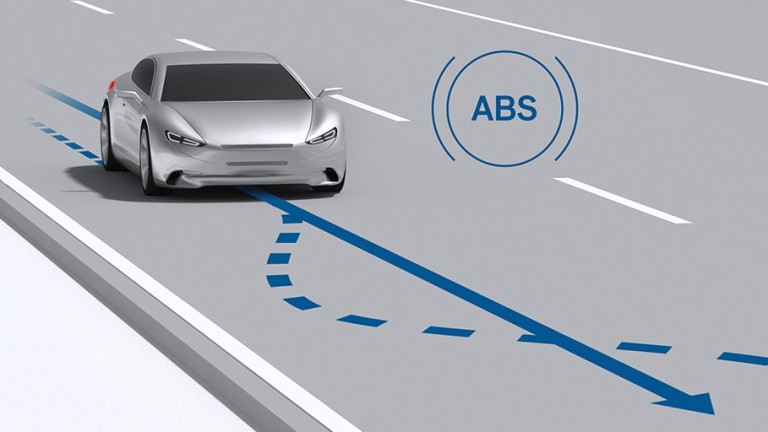
Before the invention of ABS, it was a frightening test of driving abilities if you had to suddenly prevent an accident (for example, if an animal came out on the road or if a car jumped a red light). The skill needed is known as cadence braking. This is where you brake as hard as possible while avoiding locking a wheel, which could lead you into a slide and possibly into a crash. Luckily, the development of ABS has rendered these techniques largely obsolete.
What is ABS?
ABS also known as Anti-lock Braking System or Anti-Lock Brakes, is a technology that detects and stops the wheels of a vehicle from locking during an emergency brake. When the wheels of a car stop rotating completely during an emergency brake (also known as locking), it can result in skidding and the driver losing control of the steering wheel. ABS helps prevent this locking.
How does ABS work?
ABS functions similarly to cadence braking in concept. Your car’s wheel speed is monitored by an anti-lock braking system, and if wheel lock is detected, a sensor sends a message to a controller, which releases and applies the brake up to 20 times per second, preventing a lockup and assisting you in maintaining steering control of your vehicle.

Drivers have been taught for years to apply the brakes when their vehicle begins to skid. ABS technology now automates the braking procedure, allowing you to focus on steering the car to safety during an emergency.
Modern ABS systems, however, use a four-channel controller module with individual sensors and relief valves on all four wheels, whereas older versions with one, two, or three channels would have sensors on either the front or rear axles, depending on the vehicle layout.
In modern ABS systems, sensors can detect when one wheel rotates at a different rate than the others. If the sensor detects a wheel rotating more slowly while braking, it’s an indication that the wheel is locking or about to lock. The electronics then activate a relief valve to reduce braking pressure until it is equivalent to the other wheels.
If the wheel locks up again, the procedure is repeated, much like pumping the brake pedal. This happens multiple times in a second. If you brake hard and feel the brake pedal shudder under your right foot, your car’s ABS system is working.
ABS systems use a tone ring (or reluctor wheel) attached to the car part that turns in time with the wheels, along with a magnetic speed sensor to determine wheel speed. It sends the data to an electronic control unit, which controls the ABS system via a distribution block and pump, modulating individual brake calipers.
Types of Anti-Lock Brake Systems
Anti-lock braking systems employ various strategies based on the type of brakes in use. The number of channels (the number of separately controlled valves) and the number of speed sensors used to identify them.
Four-channel, four-sensor ABS
This is the most effective scheme. On each of the four wheels, there is a speed sensor and a separate valve. The controller monitors each wheel individually in this configuration to ensure maximum braking force.
This system, which is typically seen on pickup trucks with four-wheel ABS, features one valve and a one-speed sensor for each of the front wheels, and one valve and one sensor for both rear wheels. The rear-wheel speed sensor is positioned in the back axle.
Three-channel, three-sensor ABS
This system gives each front wheel independent control, allowing them to achieve maximum braking force. The rear wheels, on the other hand, are monitored simultaneously; both wheels must lock up for ABS to kick in. It’s, however, possible that one of the rear wheels will lock during a stop with this setup, lowering brake efficacy.
One-channel, one-sensor ABS
This technology is widespread on pickup trucks equipped with rear-wheel ABS. It has a one-speed sensor in the rear axle and one valve that controls both rear wheels.
This system works in the same way as a three-channel system’s back end. The back wheels are monitored together, and both must begin to lock up before the ABS activates. It’s also possible that one of the rear wheels will lock in this setup, lowering brake efficacy.
This system is simple to recognize. One brake line is usually connected to both rear wheels through a T-fitting. Look for an electrical connection near the differential on the rear axle housing to find the speed sensor.
Benefits of ABS
ABS improves braking performance without a doubt. The major benefit of ABS is that a car’s steering will continue working even when the driver is applying full brake pressure. The forward momentum of a car with locked wheels overcomes the tire grip and any steering that is been applied. However, because the ABS-equipped automobile’s wheels will continue to rotate, the car will follow the direction of the steered wheels.
Another advantage of ABS is that tests have shown that a car fitted with ABS braking on tarmac will stop at a much shorter distance than an identical non-ABS automobile, even when that car is being driven by someone who is experienced in cadence braking.
Problems with ABS
These benefits are substantial and surpass any disadvantages. That said, there are a few disadvantages to be aware of:
Firstly, when driving on loose surfaces, ABS might make it difficult to stop your automobile. The anti-locking mechanism can become confused on loose dirt, gravel, snow, or any low-grip surface, and the continual release that the electronics engage in can actually lengthen stopping distances.
A locked wheel is more effective at stopping on loose surfaces because it ‘digs in’ to aid in stopping. As a result, many off-roaders include an off-road mode that decreases the effectiveness of the ABS or disables it entirely to improve low-speed grip.

If your car’s ABS system is malfunctioning, an orange warning light will illuminate on the dashboard. Damaged sensors and blocked release valves are common ABS issues, while most ABS-equipped vehicles are generally reliable. If your automobile has ABS difficulties, it’s best to have it checked by a garage or mechanic to have it fixed or repaired for your safety.
Conclusion
Anti-lock brakes may require some modest maintenance, such as periodic sensor inspections and possible sensor replacement. Unless you routinely drive through adverse weather conditions, basic maintenance is usually relatively minimal.

